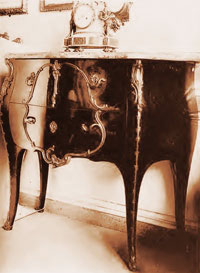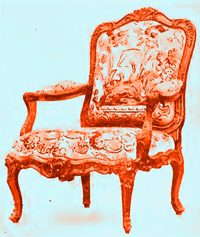Louis XV Style
The style of Louis XV reign came as an infusion of fresh vitality in French furniture design. The solemnity of the last years of Louis XIV reign gave way first to a transitional period, the Regency or Régence style.
A rather artificial classification, Regency just combines elements of the previous period with features of the new style, the Rococo (from the French Rocaille - rock, and coquille - shell, the main decoration motifs of the epoch). After the new king reached his majority, the exuberance of the youth will be gradually reflected in all decorative arts.
We should note here that the Louis XV style proper is actually dating from about 1750. So, the longer Louis XV period can be considered as having two parts: Rococo and the Louis XV proper.

Commode Louis XV
The style of the Louis XV period is marked by a greater suppleness in the lines of furniture, a more constant use of ornamental metal sculptures, rococo details, and the irregular harmony of related parts. The greatest furniture-maker of the period was Charles Cressent, whose work attains the same level of craftsmanship as that of Boulle, if not surpassing it in elegance. Copper played a great part in the ornamentation of his coloured marquetry works.
The most representative for the Rococo style was J. A. Meissonier.
Despite being a less restrained style than that of Louis XIV, it was more elegant, and in some ways more graceful, however sometimes it carried its extravagance too far. The monkey was all the rage as a decoration motif, together with Chinese and Japanese screens, jars and fans. In France, however, the Chinese motifs were artistically modified, and the " chinoiserie" of Watteau and Gillot has only a faint flavour of the real Far East.
Pastoral scenes by Watteau were used in decoration, and rococo details, natural flowers, festoons, baskets, and ribbon and lace effects.
The Louis XV style proper, however, was a purely a French development, built upon the Louis XIV style, with very little foreign influence. It was a capricious style, exaggerating later Louis XIV models, with the use of curves on a much larger scale, and rococo details.
In 1753 Louis made a royal institution of the Sèvres porcelain factory, adding a new impetus in this field of applied art. Under Madame Pompadour Sevres porcelain plaques were much used to enrich cabinets or writing-desks.
The dominant decorative motif was the rococo or rocaille, used asymmetrically, or, if you wish, in a sort of “irregular” symmetry. It was used in combination with ribbon and lace effects, flowers and hanging baskets, the broken shell, the curled endive, the twisted acanthus, and the flowing scroll. The endive or celery motif was sometimes replacing the classic acanthus.
These ornamental details were used lavishly in interior woodwork, on cornice, wainscot, mantel, door and window casing, and panel and picture frame. Furniture was designed to conform with these ornamental details of the interior woodwork.

Louis XV Chair
Walnut, upholstered with tapestry
Plain surfaces were avoided, everything being profusely ornamented, chiefly with elaborate mounts of bronze and ormolu, as well as carving. Toward the end of Louis XV reign there was a slight reaction toward greater symmetry and simplicity, foreshadowing the style Louis XVI.
The Louis XV furniture was made of many kinds of woods, including mahogany, as well as cherry and cheaper woods painted and gilded. Marquetry was not employed extensively, though we sometimes find inlay of tulip, rosewood, maple, and amaranth on some of the larger pieces. The doors and panels of commodes, cabinets, were often veneered, with the grain of the wood running diagonally.
All the larger pieces were embellished with metal mounts and carved applique, most of it exhibiting superb workmanship.
Besides chairs, there were many other noteworthy pieces, like side tables, elaborately carved consoles, and decorated cabinets and commodes. The boudoir was developed as a sort of informal reception-room, and great skill was exercised in the development of its decoration and furnishing. Screens with carved and gilded frames surrounded specially woven floral and pictorial tapestries. A multitude of screens were painted by Watteau and Boucher.
In conclusion, the details of the Rococo style were asymmetrical, but the overall effect was not, it was a balance of masses. During the Louis XV period, the science and the skills displayed in the treatment of curves attained a level not seen with any other style in the history of art.
